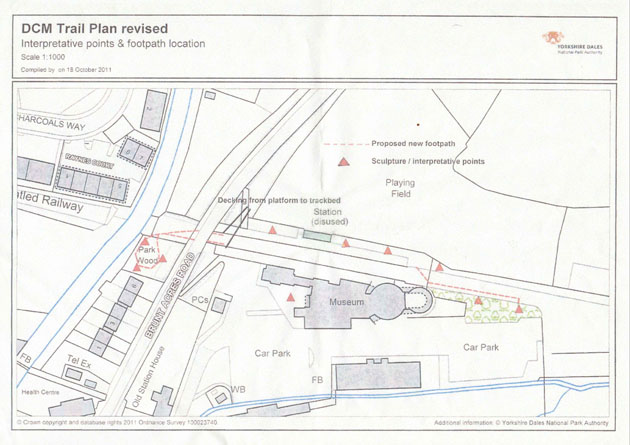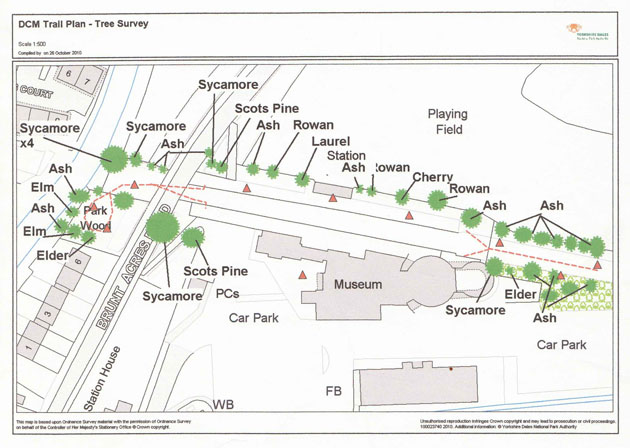Dales Countryside Museum – Commission Brief
This page outlines the Commission Brief – follow links below for other details
Stages of Carving Design Statement Sculpture Commission Process Grand Opening
Commission Brief Hidden Secrets Trail – Dales Countryside Museum 2012

Proposal to create an interpretive trail
The proposal is to create a stimulating and creative outdoor space within which people of all ages will be encouraged to explore and appreciate the cultural wildlife, landscape and built heritage of the Dales. It will be a positive addition to the Dales Countryside Museum offer, and will be a way of attracting new visitors, particularly family groups.
The intention is for the outdoor space to feature artwork by Yorkshire artists and makers and highlight the skills and creativity of contemporary trades within the Dales and will act as signposts to other sites in the area. The area will be buggy and wheelchair friendly.
Aim
Creation of external interpretation points within the Dales Countryside Museum site.
Objectives
To interpret elements of the cultural, wildlife, landscape and built heritage of the Yorkshire Dales in ways suited to family groups, particularly those with children under 12 years old.
In some cases to use signage to help with visitor flow.
To convey a sense of place and of the past history of the area.
Constraints
Interpretation and artworks must reflect the heritage of the Yorkshire Dales and must add positively to the ‘natural’ environment within which they will be located.
Interpretation, artworks and signage must be weatherproof and tough enough to withstand heavy visitor ‘use’.
Signage type
In order to be as non-intrusive as possible, it is proposed that stopping points are constructed of natural and natural-seeming materials relevant to their particular theme. The emphasis will be on delivering information in graphic and 3d forms with as little reliance on textual information as possible. The textural qualities of the signage material and 3d interpretive elements would be particularly suitable for visitors with visual impairments, learning difficulties and for children under 12 years of age.
Materials and size
Makers need to be aware of the access and design statement produced for the planning application and materials used need to be locally distinctive and from sustainable sources. No piece should be bigger than 3m x 3m x 3m.
ARTWORK THEMES AND OBJECTIVES
Point 1: ‘Woodland A’
Interpretive theme: This woodland is a link-back to a time when the first people arrived in the Yorkshire Dales after the last Ice Age. 15,000 years ago (the Mesolithic era), a woodland like this might have had deer, wild horses, or cattle (Aurochs) grazing in it. It is a quiet, beautiful place, full of bird-song where the cares of the modern world will slip away.
Interpretive objectives: That visitors will relax and open their minds up to the feeling of being close to nature. That visitors will understand the close spiritual relationship that these first hunter-gatherers had with nature.
Possible linked museum objects: Auroch horn, animal bones
Point 2: ‘Woodland B’
Interpretive theme: That the first woods and grasslands of the Yorkshire Dales were the supermarkets of the prehistoric era.
Interpretive objectives: That visitors will see how prehistoric peoples used the land and its resources sustainably, taking only what was needed. That visitors will understand how the land was exploited using stone tools, some traded from far away, and other materials now lost. That visitors may see just leaves and wood, but a prehistoric person would see birch bark vessels and greens for a tasty stew.
Possible linked museum objects: Animal bones, Mesolithic flint tools, Neolithic polished stone axes, Neolithic flint arrow heads.

Point 3: Railway milepost
Interpretive theme: That Hawes may seem remote, but from the earliest times it has been linked to the wider world, both through traded goods and through people coming and going.
Interpretive objectives: That visitors will be surprised at the world-wide links waiting to be discovered, for example the rhubarb plant behind the milepost originated in China.
Possible linked museum objects: Roman coins etc, Roman mileposts, Anglo Saxon reliquary, Viking ring (all migrating, conquering peoples). Items relating to other traded goods eg tickets, cheese, cattle. Food related artefacts linked to recipes using exotic spices, eg funeral cake marker.
Point 4: Landscape view from Platform
Interpretive theme: The dry stone wall along the platform and the hills beyond have their common origins 350 million years ago when the Yorkshire Dales was a steamy swamp (or under tropical sea!)
Interpretive objectives: That visitors will understand h ow the bones of the Yorkshire Dales landscape were formed over vast periods of geological time.
Possible linked museum objects: Fossils, eg stigmaria, crinoids, sponges and shellfish.
Point 5: Waiting Room
Interpretive theme: A railway waiting room is a place where people begin journeys that will add new chapters to their lives. They may be leaving forever or they may just be going to meet a friend in the next town, but each time they get on the train they will write another part of the story of the Yorkshire Dales.
Interpretive objectives: That visitors will see themselves as part of this story, however briefly. That visitors will see themselves as part of all the journeys in and out of the Yorkshire Dales and be able to identify with the emotions of some of those travellers.
Possible linked museum objects: Roman coins, Viking ring (invaders and settlers). Norah Worth quilt – patchwork coverlet created from ties sent to her from all over the world. Lead related artefacts (lead was mined and then exported far and wide using trains of packhorses). Oral history – farming and railways (stories in their own words). Literature – novels (eg Hope on, Hope Ever by Mary Howitt; Jerry and Ben by Wm Riley; Alexander Nowel who brought back the secret of fixing indigo dye and with his wealth then built Netherside Hall; George Metcalfe, a plantation owner and Counsel of Dominica; Chiang Yee (the Silent Traveller in the Yorkshire Dales); Wordsworth; James Haygarth, a 19th century farmer from Badgerdub, Garsdale, who kept a nature diary; Adam Sedgwick on 18th Century Dentdale.
Point 6: Far Platform
Interpretive theme: The landscapes of the Yorkshire Dales are of the highest quality and deserve to be looked after. Artists and photographers continue to try to capture these views whenever they can. They are also living landscapes and evidence for how people earn their daily bread is everywhere if you know what to look for.
Interpretive objectives: That visitors will be encouraged to see the landscape through the eyes of an artist, but also appreciate the balance that needs to be struck between conserving beauty and allowing people to make a living. That visitors will be encouraged to use the Museum to find out about the different features that reveal our impact on the landscape through our use of it as a resource.
Possible linked museum objects: Marie Hartley books, woodblocks, Piers Browne work, photograph collection. Link to view to South Hawes = communities that sustained themselves, market charter for Hawes, different crafts practiced in each village to serve the community – clogging, blacksmithing, woodworking, tinsmithing artefacts. Modern business.
Point 7: Park Wood 1
Interpretive theme: Rivers are the beating hearts of the Yorkshire Dales. They once provided power to grind corn and now drive turbines; they supply live-giving water to farmers and villagers; people once washed their clothes and still dip their sheep in them. Iron Age people may once have buried their dead and made offerings to their gods in them.
Interpretive objectives: That visitors will learn more about how people once used the power of the River Ure to grind corn and light their houses. That people will vicariously experience the raw energy of the river.
Possible linked museum objects: Water turbine used for farm lighting. Iron Age artefacts, Semerwater spearhead (from a lake I know but .. )
Point 8: Park Wood 2 and 3
Interpretive theme: Even today it is possible to find special places where you can sit and dream and maybe say a thankyou to the beautiful world we live in.
Interpretive objectives: That visitors will consider their own feelings about the natural world and their place in it. That people will be encouraged to look closely, focus on the small, but special. That visitors will be able to rest and be contemplative.
Possible linked museum objects: Beautiful natural objects like a pine cone or a quartz pebble; things that say thankyou, gifts given with love eg. knitting sticks, Loving Cup
Point 10: Entrance
Interpretive theme: The heritage of the Yorkshire Dales and particularly the content of the DCM and its immediate environment.
Interpretive objectives: To attract visitors to the DCM site. To introduce visitors to the idea of heritage. To engage visitors and encourage them to enjoy and learn.

